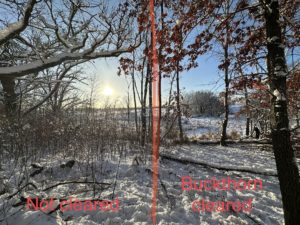Welcome to our new blog page!
We often get asked: “What does Landbridge Ecological do in the winter?” The main answer is that our focus turns from the herbaceous plant community to the woody. Winter is a great time to tackle projects like buckthorn removal and other woodland editing. The ground is frozen which means we can perform work with minimal disturbance to soil or ground layer plants. The presence of snow gives the option of burning material on site in some cases, or using heavy equipment like skidsteers in others, often providing efficiencies in our work. And by focusing woody work in the winter, we can focus on other habitats over the rest of the year, allowing a larger impact on the landscape around us.
Buckthorns tend to be our primary winter focus, of which we have 3 in Minnesota. Surprising to many, we have a native buckthorn here (Rhamnus alnifolia). However, it’s not regularly observed. The non-natives Common Buckthorn (Rhamnus cathartica) and Glossy Buckthorn (Frangula alnus) are most likely encountered. Common as one would expect is more likely encountered especially in upland areas, whereas glossy is more typical near wet areas. Though, their habitat preferences do overlap. As with other invasive species, buckthorn is a threat because it doesn’t have natural population checks and crowds out desirable native plants, lowering the quality of the habitat. Other invasive woody species often targeted in winter include Asian honeysuckles (Lonicera spp.), Amur Maple (Acer ginnala), and Burning Bush (Euonymous elatus) to name a few.
Other woody species work may include volunteer tree removal from prairie landscapes and other grassland habitats. Eastern Red Cedar (Juniperus virginiana), for example, can aggressively invade a prairie area without a good prescribed burn program in place. These trees convert prairie habitat into shrub, and eventually woodland. With only around 1% of Minnesota prairie remaining, it’s important to protect these habitats. Similarly, oak savannas are a significantly reduced habitat type and are often allowed to convert to woods. Many of our savanna projects occur in the winter, releasing old growth Bur Oak (Quercus macrocarpa) and other savanna species from encroachment. Other activities might include forest modification through stand thinning. Boxelder (Acer negundo), as an example, may be thinned as a step to help diversify low quality woodlands.
Ecological restoration is a year round gig. Have you thought about the ways in which your land could provide better habitat? Have once precious views now been taken up by the invasion of an undesirable species?
Read more about buckthorn here: https://landbridge.eco/buckthorn-removal/

Recent Comments